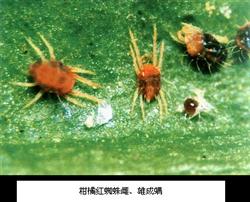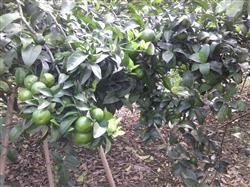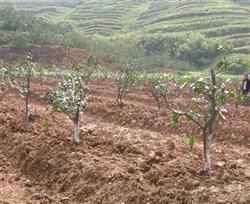What is orange spider?

What is citrus red spider? How to prevent and cure? Please introduce the citrus red spider [Panonychuscitri (MeGregor)], also known as citrus panonychus mite, which belongs to arachnida, Acari, Progasus, Tetranychidae, and is a very serious harmful mite in citrus. It is distributed in Jiangsu, Jiangxi, Fujian, Zhejiang, Guangdong, Taiwan, Hubei, Sichuan, Yunnan, Guizhou and other citrus areas. In addition to citrus, there are more than 40 perennial and annual plants belonging to 30 families, such as mulberry, pear, peach, cherry, grape, loquat and so on. 1. Morphological characteristics of adult mites: female adult mites are long 0.4mm, oval, bright red, with tumor-like protuberances on the back, upper white setae, and 4 pairs of feet. The male adult mite is long 0.3mm, the back end is slightly pointed, is wedge-shaped, the body is bright red foot 4 pairs, longer. Eggs: about 0.13mm in diameter, slightly oblate, red and glossy. There is a vertical egg stalk at the top. At the end of the handle, there are 10-12 attached filaments scattered around, which are attached to leaves, branches and fruits. Young mites: the body length of young mites is 0.2mm, light red, full 3 pairs. Nymph: the individual is small and the shape and color is close to that of adult mites. Four pairs. Second, the harmful symptoms were that adult mites, nymph mites and young mites stabbed and sucked juice on citrus leaves, twigs and fruits, and citrus seedlings and young trees suffered the most. The injured leaves showed many small gray-white spots, and in severe cases, the whole leaves were gray-white, resulting in a large number of fallen leaves and withered shoots, affecting the tree potential and yield. When rampant occurs, the surface of the fruit is covered with gray-white green spots, the whole fruit is pale, affecting the yield. Third, the occurrence regularity of citrus red spiders is the most serious in spring and autumn in one year. That is, it began to breed for damage in March. Due to the suitable temperature from April to May, the spring shoot leaves unfold and change color, and the nutrition is sufficient, the damage of red spiders is generally serious. After June, the temperature is high and the humidity is high, and there are often storms; with the growth of weeds and green manure crops in the field, a large number of predators appear; at the same time, spring shoot leaves tend to mature and nutrition level decreases. All these factors will lead to the decline of red spider population and the rapid decline of insect population. Later, with the appropriate temperature, especially in case of long-term drought, coupled with autumn shoot growth, rich nutritional conditions, rapid increase in insect population, serious damage. The red spider is the most harmful in April-May and September-November. Fourth, the life habit has to go through four periods: egg, young mite, nymph mite and adult mite. Most of them overwintered as eggs or adult mites in cracks in branches and on old leaves. Female adult mites can mate immediately after they appear, and can mate many times in a lifetime. An average of 31.7 to 62.9 eggs can be laid by each female mite in its lifetime. The number of eggs laid is the most in spring, less in autumn and the least in summer. Eggs are mostly laid on leaves, fruits and shoots, but most on both sides of the dorsal midvein of the leaves. The young mites are damaged by feeding immediately after hatching. Adult mites are distributed on both sides of the leaf, and the population density in the outer layer of the crown is higher than that in the inner layer. In the range of 20-25 ℃, the development period of each mite state shortened with the increase of temperature. The suitable temperature for development and reproduction is 20-28 ℃. When the temperature is 25 ℃ and the relative humidity is 85%, the egg stage is 6.5 days, the larval stage is 2.5 days, the pre-nymph stage is 2.5 days, the post-nymph mite is 3 days, the adult mite pre-oviposition period is 1.5 days, and the immature period is about 16 days. When the temperature is 30 ℃ and the relative humidity is 85%, the egg stage is 5 days, the larval stage is 2.5 days, the pre-nymph mite is 2 days, the post-nymph mite is 2 days, the adult mite pre-oviposition period is 1.5 days, and the immature period is about 13-14 days. The life span of female adult mites is 16: 19 ℃: 14: 25: 15: 23 ℃: 15: 24: 29 ℃: 12: 16 d. 5. The relationship between occurrence and environment the annual occurrence algebra of citrus red spider is mainly affected by air temperature. it usually occurs 12-15 generations a year when the annual average temperature is about 15-17 ℃, 16-17 generations a year when the annual average temperature is about 18 ℃, and 20 generations a year when the annual average temperature is about 20 ℃. 6. the main factors affecting the population density of red spiders are temperature, humidity, food, natural enemies and human factors. In general, the temperature of 12-26 ℃ is beneficial to the occurrence of red spider, and the optimum temperature is about 20 ℃. Due to the influence of temperature, the occurrence of red spider has two peak periods, which usually occur from April to June and from September to November. The relative humidity most suitable for the occurrence of red spiders is about 70%, and heavy rain is not conducive to occurrence. The young tissue of citrus is the best food. There are many species of natural enemies of citrus red spiders, and nearly a hundred species have been found. among them, the mites that can significantly control the occurrence of red spiders are Amblysiella Nissl, Amblysiella kangbarensis, Amblysia longicornis, Tetranychus, Tetranychus, Araneae, Chrysopa, Chrysopa, thrips, deep-spot ladybugs, abdominal tube mite ladybugs, insectivorous algae, budding mold and non-connotative virus and so on. In orchards rich in natural enemies, red spiders can be naturally controlled, especially in the middle and later stages of the growing season. The main way to influence the artificial influence of red spiders is through the use of drugs in orchards, proper use of drugs can make red spiders get better control, while unreasonable frequent use of drugs will kill a large number of natural enemies, making the occurrence of red spiders more rampant and showing a multi-peak state. 7. The method of pest investigation began in the middle of January, and 5 citrus orchards of different types were selected. There are 3 or 5 representative trees in each garden. The survey was conducted every 10-15 days, and every 7-10 days from March to April and September to October. Each tree crown takes 4 leaves according to east, south, west, north and middle, a total of 20. The number of mites, eggs and natural enemies on the leaves of spring and autumn shoots were examined with 10-20 times hand-held magnifying glass. If it is found that the number of leaf mites per 100 is more than 100 and the number of natural enemies is less than 10, a forecast should be issued in time. In the years of drought in winter and spring and high temperature, the average ten-day maximum temperature in March is 20: 25 ℃, and the ten-day rainfall is below 10mm. At this time, a large number of winter eggs are hatched, and the sprouting and sprouting of orange trees are sufficient, which shortens the development period of each mite and accelerates the rate of reproduction, which will lead to the rampant occurrence of citrus mite in that year, which needs to be controlled in time. If the basic number of overwintering leaves is less than 50 mites and the number of natural enemies is more than 20, the monthly average maximum temperature of 4 months from December to March is on the low side, totaling less than 60 ℃, and the total rainfall is above 100mm, it generally occurs less and causes less damage. 8. control methods of citrus mites the control of citrus mites should be considered from the overall situation of the citrus orchard ecosystem and carry out the policy of "prevention first and comprehensive control". Rational use of pesticides, protection and utilization of natural enemies, give full play to the natural control role of the ecosystem, and control the damage of harmful mites below the economic allowable level. 1. Agricultural control: strengthen the management of water and fertilizer in citrus orchards. Timely irrigation during drought in winter and spring can promote the emergence of spring shoots, facilitate the occurrence and prevalence of parasitic bacteria and predatory mites, and cause an unfavorable ecological environment for harmful mites. Combined with pruning and pruning in winter, overdense branches and damaged branches, rolled leaves and galls of diseases and insect pests were cut off, so as to reduce the source of overwintering mites and reduce the occurrence base. Planting Hawking thistle, rape, alfalfa, hemp and legume in citrus orchard can not only improve the microclimate of citrus orchard, but also help prey mites and other natural enemies to multiply and supplement food, and improve the natural control effect of natural enemies on harmful mites. two。 Quarantine measures: citrus tumor mite is a domestic quarantine object, which can spread with the transportation of seedlings or scions. Quarantine in place of origin should be given priority to. It is forbidden to transfer seedlings, scions or fruits from epidemic areas to avoid spread. 3. Biological control: there are many natural enemies of citrus red spiders, such as amblysid mites, long-beard mites, mite-eating ladybugs, six-spot thrips and so on. If they can be protected and utilized, the occurrence of citrus red spiders can be effectively controlled. It is effective to control citrus red spider by breeding, protecting and using Amblyseius mite (a predator mite). Keep or artificially plant thistle (white flower grass) to cover the border in the citrus orchard, and use its pollen to provide good food, habitat, spawning and breeding place for Amblyseius mites. It can also adjust the orchard microclimate and soil temperature and humidity, and create a good ecological environment for the growth and development of citrus roots and the reproduction of Amblyseius mites. In addition, thistle can be used as green manure in orchard after harvest. According to the investigation, each adult mite of Amblyseius can prey on more than 10 eggs of citrus red spider every day. There are more than 10 young mites. If there are an average of 0.1 amblyseius mites per leaf, there is no need for spray control. From March to May and from September to October, 200,400 predatory mites such as Amblyseius mites were released from citrus trees with an average of less than 2 harmful mites per leaf. The damage of spider mites can be controlled for one and a half months. It is strictly forbidden to spray highly toxic pesticides after the release of natural enemies. Hairy bacteria is an important factor to control citrus rust mites. Therefore, in the rainy season when hairy bacteria are prevalent, it is not suitable to use Bordeaux liquid and other copper fungicides to prevent diseases in citrus orchards. In addition, predatory ladybugs, thrips, lacewings and other natural enemies can be introduced to control harmful mites. 4. Chemical control: master the critical period, reduce the base number of mites in the early stage, and control the rampant in the later stage. Tetranychus panonychus citrus was first sprayed when the buds of spring shoots grew 2~3cm and the winter eggs hatched in full bloom. The occurrence of citrus leaf mite in spring is more than half a month earlier than that of citrus panonychus. Spray control should be mastered when spring shoot buds grow 1cm. When harmful mites are found in 20% of the leaves and fruits, or observed with a 10-fold portable magnifying glass, there are an average of 5 insects per leaf, spray should be organized immediately. When spraying citrus rust mites, first spray the inside of the crown, and then spray the periphery of the crown, paying special attention to the dark side of the leaf back and fruit. The citrus tumor mite leaves during the overwintering in spring, and when the old gall is harmful to the new shoot, the tree crown is sprayed for 2 times from the initial stage of shoot germination to flowering. It is necessary to choose agents that are safer to natural enemies and have good acaricidal effect, because citrus red spiders are very easy to produce drug resistance, and the drug resistance acquired may be inherited, so it is necessary to rotate reasonably when using chemical agents, and never use the same agent continuously for a long time to prevent or delay the drug resistance of red spiders. At the same time, try to use the way of picking and treating, so that the natural enemies of red spiders have room for manoeuvre. Pay attention to prevent drug damage: try to avoid midday application, use the recommended concentration, and avoid using organotin (triazoltin, triphosphate tin, phenylbutyltin) and special acaricides in young fruit and high temperature period as far as possible. Commonly used medicament: spiromites, acetylene mites, nisolan (thiazox), dacaron, phenylbutyltin, triazotin (do not be used from spring sprouting to Xiehua), amitraz, butyl ether urea, dacarine, probophos, avermectin, bifenthrin, fenpropathrin, bromine acarate, azolyl acarate. Click to get more citrus planting techniques click to get more fruit planting techniques
- Prev

How to protect the fruit of autumn dry oranges?
How to protect the fruit of autumn dry oranges? Please introduce the autumn dry citrus can refer to the following methods to protect the fruit: first, the orange orchard with irrigation conditions can be irrigated in the afternoon, the water depth is slightly lower than the border surface, through the infiltration of one night, the excess water from the garden will be discharged the next morning to avoid high heat at noon and root damage; no irrigation.
- Next

How to grow oranges to prevent drought?
How to grow oranges to prevent drought? Please give guidance to citrus cultivation vulnerable to spring drought and summer drought. Spring drought mainly occurred from February to May, which was characterized by affected flower bud differentiation, low water and abnormal shedding of late-maturing citrus, curly leaves, increased abnormal flowers, granulation and water loss of fruit cysts, decreased quality and flowering.
Related
- Moge, come on! The staff of the peasant association in the producing area of cantaloupe were frightened when the crowd gathered.
- Causes and Solutions of low Fruit setting rate of Apple
- Symptoms and control measures of passion fruit virus disease
- Fruit growing lesson: how do apple orchards keep high yields?
- Can you build orchards in the mountains? What are the pros and cons?
- How to manage the coloring period of Crisson grape?
- This paper introduces the processing technology of two kinds of fig products.
- How much is a month for retired teachers in rural areas by 2020?
- How can strawberry planting increase sugar content? We should pay attention to management in many aspects.
- What are the cultivation techniques on how to improve the yield of golden fruit?

